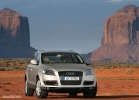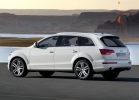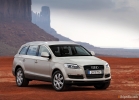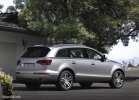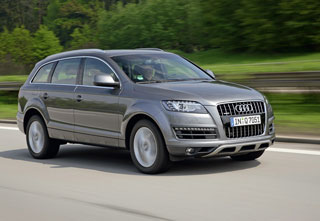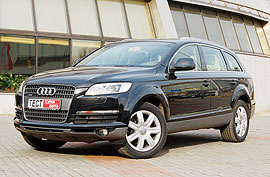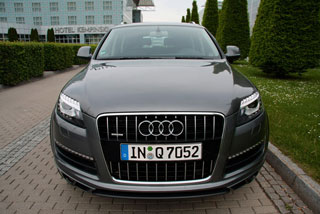Test drive Audi Q7 2006 - 2009 SUV
Higher class Audi Q7 V12 TDI Quattro: Everything except modesty
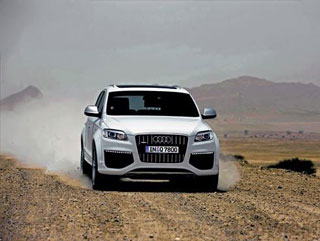 He is huge and strong, like a young elephant. Its 6-liter 12-cylinder diesel diesel develops 500 hp. and is able to twist the transmission by a moment of 1000 N.M. Modelity is not peculiar to him in principle. The habits of the Audi-Q7 beast with a new supermore was studied by Anatoly Fomin. Photo by the author and audi.
He is huge and strong, like a young elephant. Its 6-liter 12-cylinder diesel diesel develops 500 hp. and is able to twist the transmission by a moment of 1000 N.M. Modelity is not peculiar to him in principle. The habits of the Audi-Q7 beast with a new supermore was studied by Anatoly Fomin. Photo by the author and audi. The sizes of Q7 a priori exclude all thoughts of modesty. More than 5 meters length, 3 meters of the wheelbase, 2 meters width, 20-inch wheels with 295/45R20 tires, a equipped mass of 2.6 tons. These are the characteristics of the V12 TDI Quattro modification of the very one that has recently been an exhibition concept.
The embodiment of the idea
A super -powerful motor in an ordinary car, such as a large crossover, a good recipe for making a memorable dish. Full -wheel drive, modern chassis, a fairly low location of the center of gravity allow you to realize the huge potential of the engine without any problems. The eternal rival of Audi from neighboring Munich showed the BMW X5 Le Mans in Geneva in 2000. He had a 12-cylinder 700-horsepower F1 Mc Laren McLaren engine under his hood. The car gathered crowds of visitors, set a record in his class at Nürburgring (7 min 49.92 s), but did not become serial. Audi's company went its own way: instead of a highly compiled atmospheric gasoline engine, she decided to hide a 12-cylinder turbodiesel under the hood of her leviafan, albeit more modest in power, but with a monstrous torque. Moreover, Audi brings the case to the end and puts the car into the series.
Power is primarily speed. Even such a giant as Audi-Q7, less than 400 horses under the hood is enough to put the speedometer arrow on a voluntary restriction of 250 km/h. What are 500 horsepower and 1000 nm of torque?!
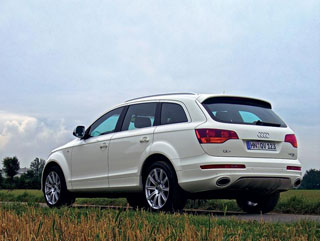 Half a minute before the separation
Half a minute before the separation Not even so exclusive audi-Q7 with diesel eight is very fast and extremely comfortable. What is his fellow who has cylinders and relics one and a half times more? Even faster and more comfortable?
You just have to start the engine to make sure: the V12 TDI Quattro does not look like a giant plush toy. The roar of a 6-liter engine unobtrusively penetrates the salon with the most careful touch of the right pedal, light vibration makes it doubt that under the hood is a perfectly balanced 12-cylinder engine.
The most important thing when managing the Audi-Q7 V12 TDI Quattro is very neat with the right pedal. Because even the fastest movement of it with an amplitude more than a centimeter responds instant impetus to the lower back. It seems that there is no hydrrotransformer in the transmission at all, the inertness of the full drive to the car is in principle unknown. And if you press the pedal from the heart, the sensation is comparable only with the experienced in the take -off liner. A little more than 30 seconds and you can take the helm against yourself!
Even accelerating to 200 km/h, the car has a huge reserve of dynamics. At first, it’s hard to get used to it. However, why get used to? Enough to believe that the possibilities of acceleration are not limited! The designers did not get involved in long gears and imprisoned the transmission under the greatest acceleration. Thanks to the complete drive, all the capabilities of the motor are realized without unnecessary problems. Of course, if we are talking about dry asphalt, where the tires 295 mm wide can give the road all their clutch abilities.
Blowing a loaded three-ton car is much easier than it seems: giant ceramic brake discs (420-mm with eight-piston calipers for front and 370-mm four-piston for rear wheels) easily and without problems transfer kinetic energy into thermal. The size of the wheels in which they are placed 20 inches. These are the smallest that can be found on Audi-Q7 V12 TDI Quattro. An alternative to them 21-inch with lower-profile tires and three design options (20 knitting needles).
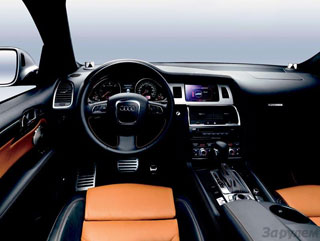 If there is no doubt in the ability to accelerate and confidently slow down from the impressive speed, then they were about the passage of turns. Despite the impressive size and mass of adult hippopotam, this ku-seventh turned out to be more than agile. The engineers who brought the chassis clearly sacrificed comfort for the sake of controllability. As a result, even in comfortable suspension mode, the car remains quite rigid, but unquestioningly responds to the slightest movement of the steering wheel. In the bend of the middle radius, you literally feel the crazy clutch of the wheels with the road with your skin.
If there is no doubt in the ability to accelerate and confidently slow down from the impressive speed, then they were about the passage of turns. Despite the impressive size and mass of adult hippopotam, this ku-seventh turned out to be more than agile. The engineers who brought the chassis clearly sacrificed comfort for the sake of controllability. As a result, even in comfortable suspension mode, the car remains quite rigid, but unquestioningly responds to the slightest movement of the steering wheel. In the bend of the middle radius, you literally feel the crazy clutch of the wheels with the road with your skin. I would also like to add gas, but suddenly a strange feeling of caution covers. It seems that the power of the engine and the clutch of the car with the road are so large that the engine will rather flatten hardened balls in the hinges of equal angular velocities than tore the wheels into the slip. The electronics of the stabilization system will not allow the machine to get out of control, but will allow you to enjoy speedy turns.
I want even faster? You can turn off the electronics. Only you need to remember: a barely monstrous torque will test the wheels, Audi-Q7 V12 TDI Quattro will go completely differently. In these modes, you can no longer reset the mass from accounts even to a driver with good skills in all -wheel drive machines must be prudent. There will always be enough traction, since 1000 N. M torchs are available at 1750 rpm and will not bend up to 3250 rpm. Moreover, this range is much wider than it seems!
But with the usual riding of Audi-Q7 V12 TDI Quattro, it seems rough.
The car is inferior to its modest brothers with calmer engines in comfort and equanimity. However, he is too special to just ride. He needs to demonstrate his strength every now and then. When an active ride provokes a car weighing more than 2.6 tons, there is something in it!
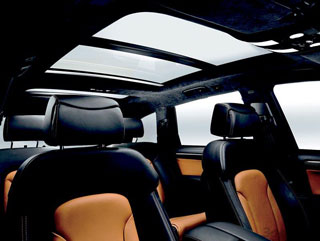 Ideal athlete
Ideal athlete Audi-Q7 V12 TDI Quattro outstanding athlete. Multibore? No. Maybe a weightlifter? No, but already warmer. So the bodybuilder? Apparently yes. He manages to strain too expressively. Too diligently, he is ready to perform exercises. Although, perhaps, excessively massive to set absolute records. But damn strong, amazingly complex and absolutely unique. Ideal athletes do not have their own champions in every sport.
Negruk
A six -liter diesel is usually found on modern trucks with a full weight of 1618 tons. Such an engine in a passenger car? No, the cargo engine has only half the power and number of audi cylinders of this volume, although it will not yield in the size of the torque. And the truck engine will turn out to be one and a half heavier times, much larger in size (especially in height) and will develop maximum power with half the speed. In addition, he has a narrow working range, which is usually compensated by nine twelve gear. In general, even for a large but passenger car is not at all suitable!
Audi-Q7 V12 TDI QUATTRO The most powerful diesel car today. His dynamics match the power, but the impression that he makes on the driver is much brighter!
A huge crossover accelerates so that the sensations of the vestibular apparatus do not converge with reality disappearing behind the stern.
Six and twelve
Audi diesel diesel has a length of 684 mm by 166 mm more than eight -cylinder. Its unique cylinder block with a collapse angle of 60 degrees. Audi no longer has such: six- and eight-cylinder engines of the company have a collapse angle of 90 degrees. It is not optimal for sixes, but the problems of insufficient smoothness are solved by balancing shafts. The twelve -cylinder engine is not necessary to balance the correct configuration.
The injection pressure in the power system Common Rail thanks to two UNVDs and nozzles with piezo elements is the maximum of 200 MPa today. Of course, there are a pair of turbochargers with a variable guide to the turbine, and huge radiators of chill air (boost pressure 1.7 atm), and controlled recirculation of gases with cooling in a separate heat exchanger.
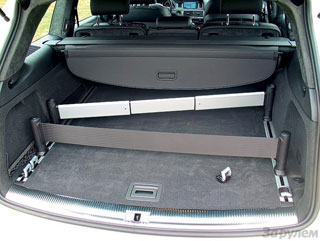
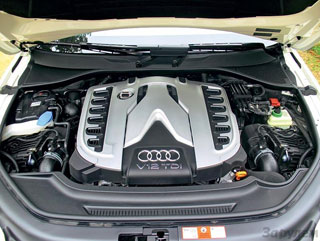
A source: The magazine "Driving"
Video test drives Audi Q7 2006 - 2009
Video crash tests Audi Q7 2006 - 2009
Audi Q7 2006 test drives - 2009
Crash Test Audi Q7 2006 - 2009
Krassh Test: Detailed Information30%
Driver and passengers
15%
Pedestrians
39%
Children-passengers

